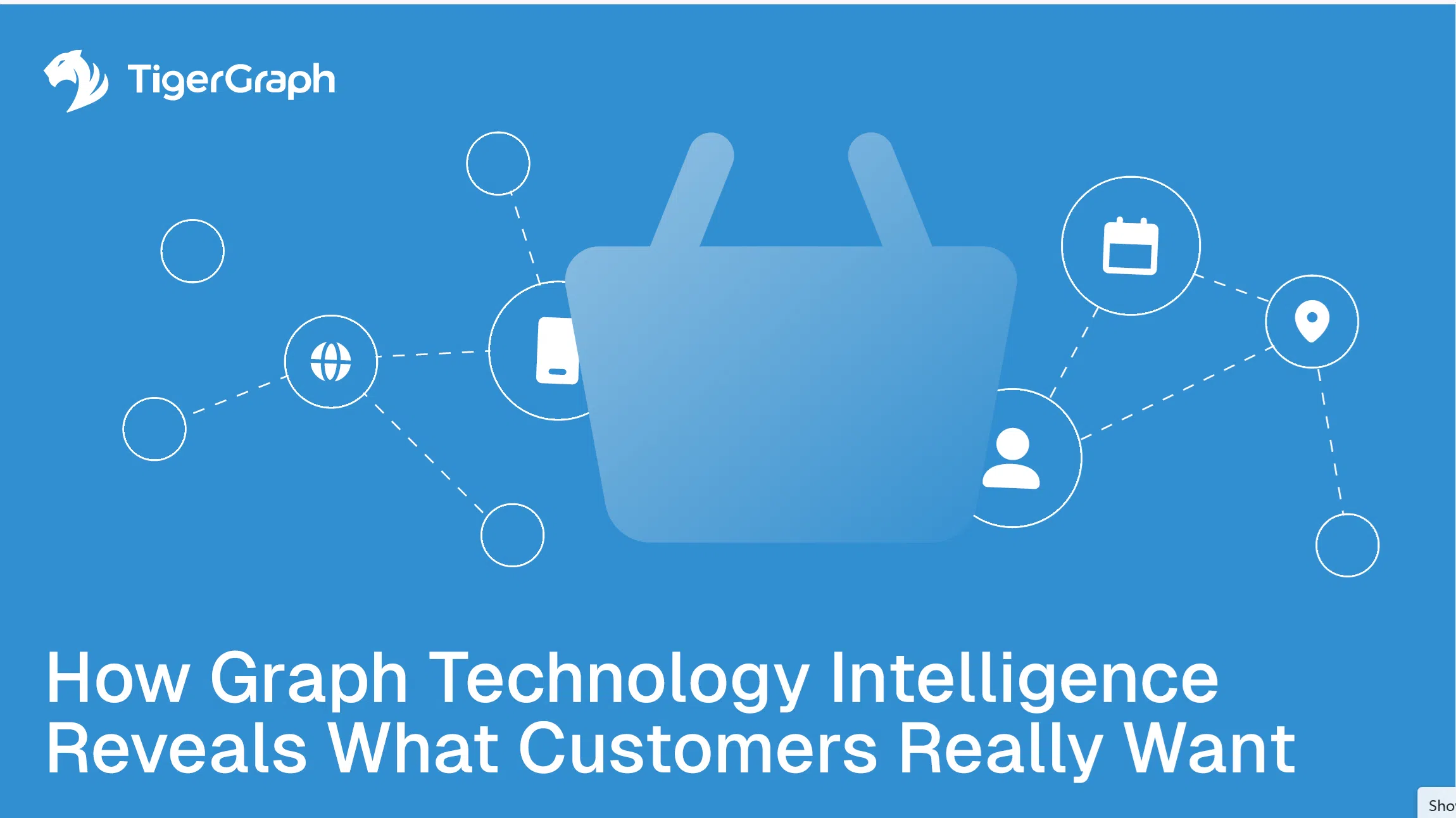How Graph Technology Intelligence Reveals What Customers Really Want
Your customer just placed an order, but do you know why they bought? Were they shopping for themselves, a household member, or someone else entirely? Is this a one-off transaction or part of a bigger life event?
Traditional CRM systems can tell you what was purchased and when, but they can’t explain why, for whom, or what comes next. That’s because they’re built around flat records, not relationships.
This is where graph technology comes in.
Graph databases model not just data points, but the relationships between them. They create a web of connections across people, purchases, devices, locations, and behavioral signals.
This connected view reveals context that flat systems miss. And when applied to retail, graph technology enables more nuanced insight into what’s happening in a customer’s world, and how these events should shape your response.
TigerGraph takes this a step further. It offers a real-time, scalable graph platform designed for complex, dynamic customer data. With TigerGraph, retailers can build adaptive Customer 360 systems that surface relationships, spot shifts in behavior, and respond with timely, relevant engagement.
Going Beyond “Customers Like You”
Most personalization today still relies on surface-level recommendation logic: “People who bought X also bought Y.” It’s a shallow model that treats individuals like datapoints in a crowd.
But people don’t want to be grouped by purchase history alone. They want to be understood.
Graph technology enables retailers to move past rote pattern-matching and toward relational understanding. It connects what someone bought with other available insights, like who they bought it for, what triggered the purchase, and how that behavior fits into broader lifestyle changes.
TigerGraph makes this shift real-time and scalable, enabling teams to embed that insight directly into personalization engines and decision workflows. It offers advanced multi-hop traversal, which helps teams model influence chains, shared purchasing behaviors, and household dynamics. This results in deeper segmentation so retailers can create more relevant offers, and personalization that actually feels personal.
Graph technology is all about connectional reasoning, allowing retailers to move from transactions to understanding. It is an important distinction from flat profiles, which typically fall short.
Why Flat Profiles Fall Short
Retailers know they need personalization, but if your customer profiles are built on siloed data or simplistic segmentation, you’re behind and sending out signals that are misfiring.
Consider these real-world complexities:
- Shared devices and accounts: Multiple household members might shop under one login. Without disambiguation, personalization becomes error prone. It would be like recommending pregnancy products to a shared account and revealing private information (which is a scenario that has actually happened).
- Life events and buying behavior shifts: Moving, having a baby, or starting a new job can change what a person needs, but traditional systems often do not detect these transitions as they unfold over the preceding weeks and months.
- Gifting and proxy purchases: A spike in toy purchases might not mean someone has kids. They could be buying for a friend or niece. Graph helps detect the difference.
While any graph database can model these relationships in theory, TigerGraph enables real-time traversal at scale. This allows you to surface these distinctions on the fly and adjust customer journeys accordingly, while also addressing insight gaps.
These gaps don’t just lead to irrelevant recommendations; they risk eroding customer trust. What is needed is a way to model the richness of human behavior, relationships, and shifting contexts.
How Graph Adds Context, Empathy, and Foresight
Graph technology creates a fundamentally different lens, one that doesn’t view customers as isolated rows in a database, but as individuals embedded in social, temporal, and behavioral networks.
And with TigerGraph, this power becomes operational. Retailers can:
- Map customer journeys across time and relationships: See how behaviors evolve, who influences purchasing, and how preferences spread across households.
- Identify microsegments that actually matter: Detect customers who shop late at night, show pre-holiday activity spikes, or shift categories after major life events.
- Catch preference changes early: Support continuous monitoring and streaming updates, so shifts in engagement or browsing patterns can be detected and acted on before intent becomes explicit.
This adds a layer of empathy to digital personalization. You’re offering what a customer is likely to click while also anticipating what they might need, based on who they are, what’s changed, and what’s likely to come next. The next step is activation.
Turning Relationships into Results
While graph technology gives you the blueprint for connected customer understanding, TigerGraph equips retailers to activate it at scale.
Many graph databases can model relationships. But when you need to track millions of purchases, identities, and interactions across multiple channels, and in real time, you need a platform purpose-built for enterprise speed, volume, and complexity. That’s where TigerGraph stands out.
TigerGraph enables retailers to:
- Unify fragmented data through entity resolution: Customer data is often scattered across systems, like loyalty platforms, ecommerce tools, CRM, customer service logs. TigerGraph resolves this into a cohesive graph structure, linking disparate records into a single view of each customer and their connections.
- Model householding and shared-device behavior with precision: TigerGraph supports multi-hop traversal and relationship weighting, allowing teams to distinguish between individual, shared, and proxy purchases, and to respond accordingly.
- Surface real-time context with streaming graph updates: As new data comes in, TigerGraph updates relationship paths dynamically. That means you’re not just reacting to what customers did last month, but responding to what changed five minutes ago.
- Predict emerging needs before customers ask: With built-in AI and ML integration, TigerGraph allows you to train predictive models based on graph features. You can detect behavioral drift, segment customers based on evolving patterns, and deliver preemptive offers or outreach with confidence.
- Avoid critical missteps through explainable logic: Graph queries in TigerGraph are schema-first and traceable, which supports not only better results, but better reasoning. You can audit why a recommendation or flag was generated, which is a key factor in privacy-sensitive or regulated environments.
TigerGraph gives you a living, learning customer model that evolves as your customers do and keeps your brand in step with what they really need. It allows retailers to move seamlessly from recommendation to recognition.
From Recommendation to Recognition
The next frontier of retail personalization isn’t just smarter suggestions; it’s genuine customer recognition. That means seeing the full context behind a customer’s choices: their life stage, household dynamics, shifting preferences, and intent before it’s explicit.
Graph technology makes this possible by connecting the dots between customers, behavior, and relationships. But only TigerGraph makes it practical at enterprise scale — delivering real-time insights across billions of interactions, streaming updates, and explainable AI-driven predictions.
If you’re ready to move beyond transactional tactics and into contextual, connected customer experiences, start with graph.
Scale it with TigerGraph and give your customers more than a recommendation. Give them recognition.

